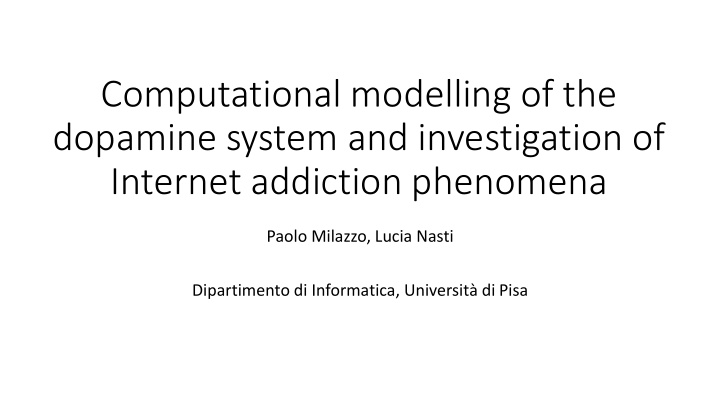



Computational modelling of the dopamine system and investigation of Internet addiction phenomena Paolo Milazzo, Lucia Nasti Dipartimento di Informatica, Università di Pisa
What is addiction? • Addiction is a complex phenomenon influenced by environmental, social and biological factors. Environmental factors: Social factors: Biological factors: ➤ Education and family ➤ Consensus ➤ Dopamine system background ➤ Imitation ➤ Stress ➤ Availability ➤ Social acceptance ➤ Chemical substances ➤ Economic Resources
The Dopamine System • Dopamine is a neurotransmitter involved in many cognitive processes • In particular, in the reward system (satisfaction) • The reward systems is the main cognitive system involved in the development of addiction
Gutkin’s model Gutkin’s model (1) specifically analyses nicotine addiction. It shows how a constant stimulus causes a consequent decrease in neuronal activity. (1) Boris S Gutkin, Stanislas Dehaene, and Jean-Pierre Changeux. A neurocomputational hypothesis for nicotine addiction. Proceedings of the National Academy of Sciences of the United States of America, 103(4):1106{1111, 2006.
Samson’s model Samson’s model (2) focuses on the role of dopamine as a reward system. • Neurons are activated in two cases: ➤ in case of a reward ➤ when a reward is predicted 2) RD Samson, MJ Frank, and Jean-Marc Fellous. Computational models of reinforcement learning: the role of dopamine as a reward signal. Cognitive neurodynamics, 4(2):91{105, 2010.
Hybrid Automata model
Some considerations • The trend of dopamine is similar to the one obtained by Gutkin. • The memory is an abstract description of the opponent process • We use the memory threshold M>=15 to represent addiction
Varying the stimulus (1)
Varying the stimulus (2)
Internet addiction • Excessive use of Internet as a mechanism to escape from the daily dissatisfaction. We represent the social network Main expressions: as a graph: ➤ Gaming ➤ Each node of graph is a user ➤ Social network ➤ Each user has a dopamine system and a propensity ➤ Surfing factor
Model assumptions • The propensity factor (real value in [0,1]) summarizes user’s predisposition to communicate (probability of sending messages) • Each user sends 0 or 1 original messages and 0 or 1 replies per day • Abstract way of representing the user involvement Dopamine stimuli: • When a user receives a message (reward) • When and addicted user sends a message (reward prediction)
Two-nodes graph Used to examine the role of the propensity factor. All possible combinations of users have been tested to count how many times each of the two becomes addicted We find three values: ➤ low propensity: 0.2 ➤ medium propensity: 0.35 ➤ high propensity: 0.9
Star graph Used to study propagation of addiction. • How many nodes n are necessary in order for c to become addicted ? • How many for x ?
Whole networks (1) Used to study the role of the (scale-free) network topology. • Random graph -- Erdős -Rényi method (ER) 20 addicted users
Whole networks (2) Used to study the role of the (scale-free) network topology. • Scale-free graph -- Barabási-Albert method (BA) 35 addicted users
Whole networks (3) Used to study the role of the (scale-free) network topology. • Scale-free graph -- Bollobás-Riordan method (BR) 52 addicted users
Summary of the results • Under our assumptions on the dopamine stimuli created by social network interactions, we have shown that: 1. Addiction can be caused by the interaction on social networks 2. Addiction can be «transmitted» through social networks 3. The topology of social networks (scale free) favours the spread of addiction
Recommend
More recommend